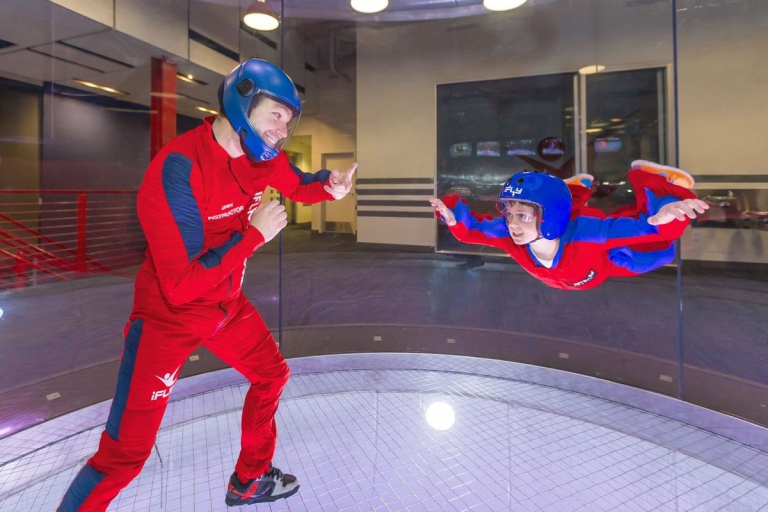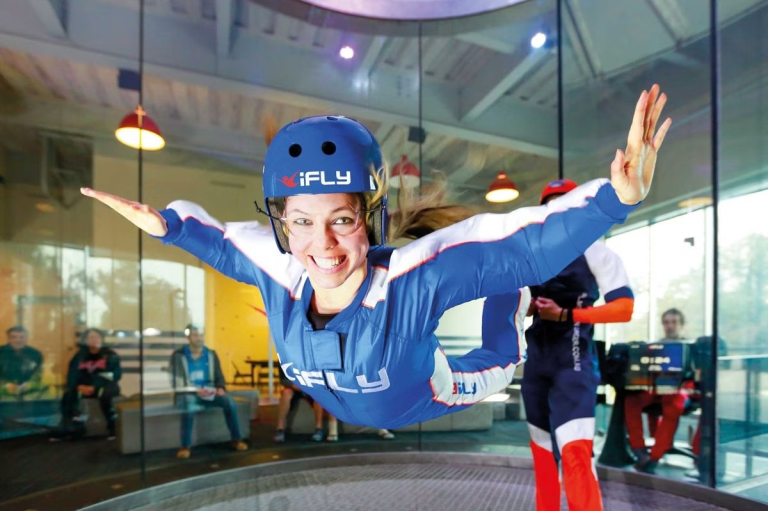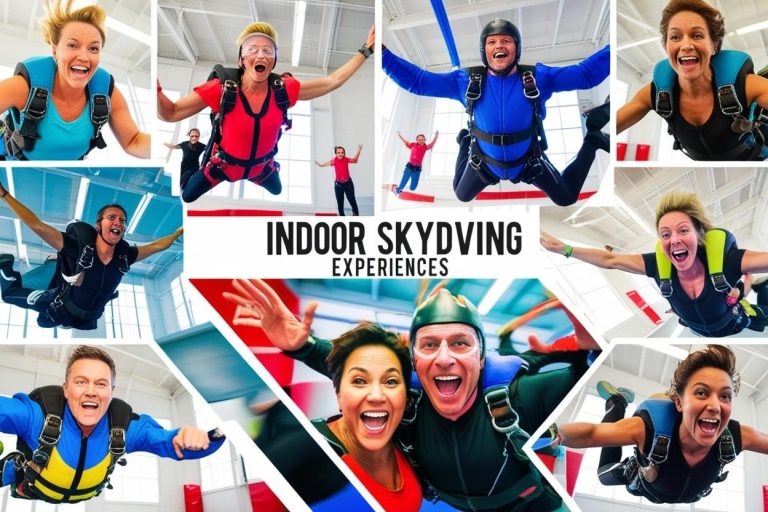Indoor Skydiving Experiences
Click on each section below to discover more about the experience.
AdrenalineExperiences.co.uk Insights...
Indoor Skydiving Experiences - Freefalling on the Ground!
Entering the world of indoor skydiving is like stepping into a realm where gravity seems to lose its dominion, allowing the thrill of freefall to be experienced in a safe, controlled environment. This exhilarating sport has been crafted to simulate the sensations of jumping out of a plane while keeping adventurers comfortably on solid ground. For many, the allure lies not only in the unusual setting but also in the chance to explore something new without the usual risks associated with traditional skydiving. The prospect of feeling weightless and performing mid-air maneuvers attracts people from all walks of life, making it an intriguing pastime for anyone seeking a unique adventure.
In this article, readers will dive deeper into what makes the indoor skydiving experience so captivating. We will unravel the fascinating mechanics behind vertical wind tunnels, the high-tech engines that power these skydiving centers. The intricate design of these structures ensures not just the simulation of freefall but also a focus on participant safety and enjoyment. You will learn about the specialized gear participants wear and how instructors play essential roles, guiding beginners through their first exhilarating flights. Beyond the technicalities, we’ll also touch upon the personal growth and joy it brings to participants as they push their boundaries. Whether you're considering your first dive or looking to enhance your skills, this exploration promises to equip you with insights and excitement for your upcoming aerial adventures.
The Mechanics of Indoor Skydiving
Indoor skydiving facilities provide a thrilling yet safe platform for those eager to experience the sensation of free-falling without leaping from an airplane. At the heart of these facilities lies the sophisticated vertical wind tunnel, which plays a crucial role in simulating the exhilarating conditions of a traditional skydive. Understanding how these tunnels operate can deepen one’s appreciation for the intricacies involved in recreating such a dynamic environment.
The design of a vertical wind tunnel focuses on generating strong air currents capable of lifting an individual off the ground. These tunnels function by channeling air through a powerful fan system, creating a controlled stream that flows upwards at high velocity. This flow mimics the forces encountered during a true free-fall, allowing participants to float and maneuver mid-air. The walls of the tunnel are often constructed using a clear material like glass or acrylic, providing not only structural integrity but also visibility, so spectators can watch as participants soar within.
A key component of the wind tunnel is its capacity to adjust airspeed according to the participant's size, skill level, and the type of flight session they are undergoing. Beginners usually require softer airflow to gain initial control, while more experienced flyers might opt for stronger gusts to perform complex maneuvers. The tunnel's design incorporates advanced technology to monitor and tweak the wind speed in real-time, ensuring that each flight is perfectly tailored to the individual’s needs. This precision is vital for both safety and the quality of the experience.
As integral as the wind tunnel is, equally important is the gear provided to participants. Flight suits, helmets, and goggles are standard requirements before entering the wind chamber, each serving distinct functions to enhance safety and overall comfort. The flight suit, typically made from durable yet lightweight material, helps reduce drag and allows for more aerodynamic movement through the air. It ensures that the slightest shift in body position translates efficiently into directional changes, granting flyers better control over their motions.
Helmets are another non-negotiable element, safeguarding against any accidental bumps or knocks within the confined space of the tunnel. They’re designed to shield the head without obstructing vision or hearing, maintaining both protection and sensory awareness. Complementing the helmet are the goggles, which guard the eyes against the constant rush of air. Keeping vision clear and undistorted is crucial, allowing participants to maintain orientation and focus amidst the whirlwind environment.
Beyond the equipment, the human factor plays a pivotal role in the indoor skydiving experience. Every session begins with a comprehensive safety briefing conducted by certified instructors. These professionals possess extensive knowledge of aerodynamics and the operational intricacies of the facility. During the briefing, participants learn about body positioning, hand signals used for communication while flying, and various ways to safely enter and exit the wind chamber. This grounding knowledge equips them with the confidence needed to enjoy their airborne adventure fully.
Instructor guidance does not cease with the initial briefing. Throughout the flight, instructors remain present, offering real-time feedback and assistance. They stand poised at the edge of the tunnel, ready to step in should a flyer need help regaining balance or trying new techniques. Their expertise ensures that safety is always prioritized, nurturing an environment where enthusiasts can explore their capabilities securely.
Furthermore, instructors tailor their guidance to accommodate different skill levels. Novices benefit from hands-on support and gentle corrections, easing them into the sensation of floating effortlessly. As participants progress, instructors gradually introduce advanced maneuvers and tricks, encouraging personal growth and mastery of flying skills. This individualized approach fosters a rewarding experience that’s as educational as it is enjoyable.
Instructors also serve as mentors, inspiring returning flyers to push their boundaries further. By breaking down each flying technique and offering personalized tips, they establish a learning framework that enables ongoing improvement. With their patient tutelage, many find themselves rapidly advancing from basic stability exercises to intricate aerial artistry.
Experience Highlights and Considerations
Indoor skydiving offers a unique thrill that combines the sensation of freefall with the safety and convenience of staying indoors. For those who have never tried it before, understanding what happens during a session can help alleviate any apprehension. When you step into the wind tunnel, you're met immediately with an exhilarating rush as the high-speed air lifts you off your feet. This lift-off is often described as a powerful but controlled adrenaline surge. As you float, maintaining balance becomes crucial. The experience requires subtle adjustments of your body to stay stable in the airflow, turning your position and poise into key aspects of the adventure.
Being accessible to a wide range of people is one of indoor skydiving's greatest attributes, yet certain factors must be considered to ensure safe participation. Age and weight limits are common conditions that facilities enforce strictly. Typically, participants must be at least three years old, making this activity suitable for young adventurers too, while maximum weight restrictions usually cap around 250 pounds, varying slightly by location. These guidelines are there to make sure the equipment operates safely under controlled circumstances. Additionally, prospective flyers should consider their physical condition. While no formal fitness level is required, individuals with neck, back, or heart issues should consult a physician before booking. Once these conditions are met, the world of indoor skydiving opens up as an exciting possibility for many.
When you start planning your indoor skydiving adventure, understanding the booking process is just as important as the experience itself. Peak times, such as weekends or holiday seasons, tend to fill up quickly, so securing a slot well in advance is recommended. Sessions usually last from a matter of minutes to over an hour, depending on whether one opts for personal solo flights or group packages. Prices vary significantly based on the flight duration and additional services like video recordings or instructor coaching sessions. It's beneficial to explore different packages and read reviews to see what previous customers have found most satisfying.
For those who have already experienced actual skydiving or are contemplating both options, it's worth comparing the two. Real skydiving involves jumping out of an airplane from about 10,000 feet above the ground. It provides unmatched views and the full effect of falling through the sky. However, it also carries higher risks and often requires more preparation time, including weather considerations and extensive travel to drop zones. Indoor skydiving, on the other hand, is much more straightforward to get into, offering a simulated version that captures many elements of freefall without the uncertainties tied to traditional skydiving. It's about personal preference: some might choose the authentic thrill over convenience, while others may value accessibility and safety more.
What should you expect on the day of your flight? While each facility might do things a bit differently, they generally adhere to similar protocols to ensure a smooth and enjoyable experience. Upon arrival, you'll check in and undergo a brief orientation where instructors explain essential techniques and safety rules. Then comes flight gear fitting, ensuring everything is snug and secure. After that, it's showtime! Most places allow you several rounds in the tunnel, so you get ample opportunity to apply what you've learned. Your first few attempts may feel challenging as you adapt to modulating your body's movement, but that's part of the fun and discovery process.
Preparation tips can enhance your overall outing. Dress comfortably in lightweight clothing, avoiding accessories that could become dislodged during your flight. Ensure your shoes are lace-up sneakers or something similar to prevent them from flying off in mid-air. Eating a light meal beforehand is advisable to avoid discomfort, especially if nerves start kicking in. Arriving early to familiarize yourself with the facility also helps ease any anxieties and gives you a chance to scope out potential upgrades like recorded videos or extended sessions.
Safety measures and precautions taken by indoor skydiving operators are robust, designed to minimize risks while maximizing fun. Instructors play an integral role, remaining in the tunnel with you or monitoring closely from outside at all times to offer guidance and corrections. Their expertise means that even complete novices quickly find confidence in their new skills. Helmets, goggles, and flight suits provide necessary protection and comfort. Plus, facilities have escape procedures and first aid teams on standby, ready to act should anything arise unexpectedly.
In Conclusion
Indoor skydiving is an exhilarating experience, providing the sensation of free-falling within the safety of a controlled environment. This article has delved into the mechanics behind this adventure, breaking down how vertical wind tunnels function to create an upwards air current strong enough to lift participants and let them float freely. We've explored the importance of customized airflow, suited to each individual's skill level, ensuring both safety and enjoyment. The essential gear like flight suits, helmets, and goggles add layers of protection and comfort, enhancing participants' ability to thrive in the tunnel. Meanwhile, certified instructors are always on hand to guide and support flyers, offering real-time feedback and ensuring that every session is tailored to maximize both fun and learning.
Ultimately, we've highlighted not just the thrilling aspects of indoor skydiving but also its accessibility and inclusivity. Age and weight considerations help ensure safety for all participants, making this a versatile activity that can be enjoyed by varying age groups. With a little preparation, from booking your session well in advance to dressing comfortably and heeding medical advice if necessary, anyone can unlock the joy of flying indoors. Whether you're seeking a new hobby or simply trying something novel, indoor skydiving offers a unique combination of excitement and security few other activities provide. As you consider embarking on your airborne adventure, this chapter arms you with the knowledge needed to make your experience as smooth and memorable as possible.
We need your consent to load the translations
We use a third-party service to translate the website content that may collect data about your activity. Please review the details in the privacy policy and accept the service to view the translations.







